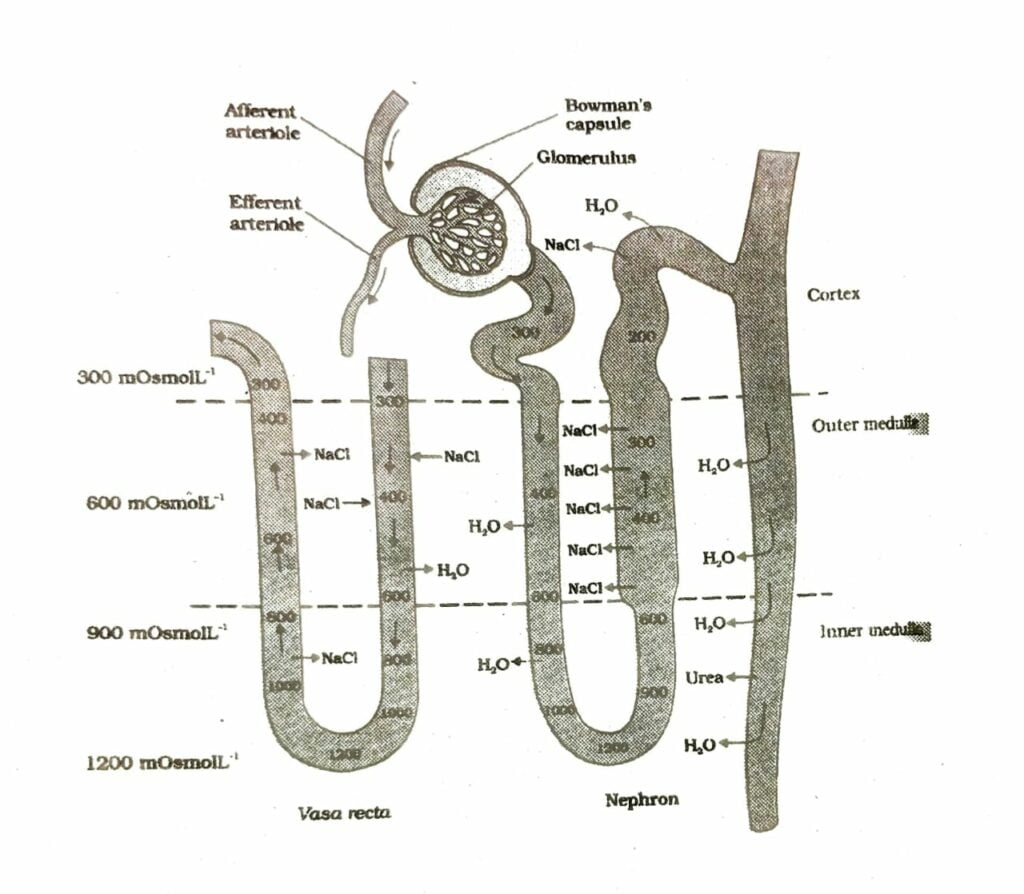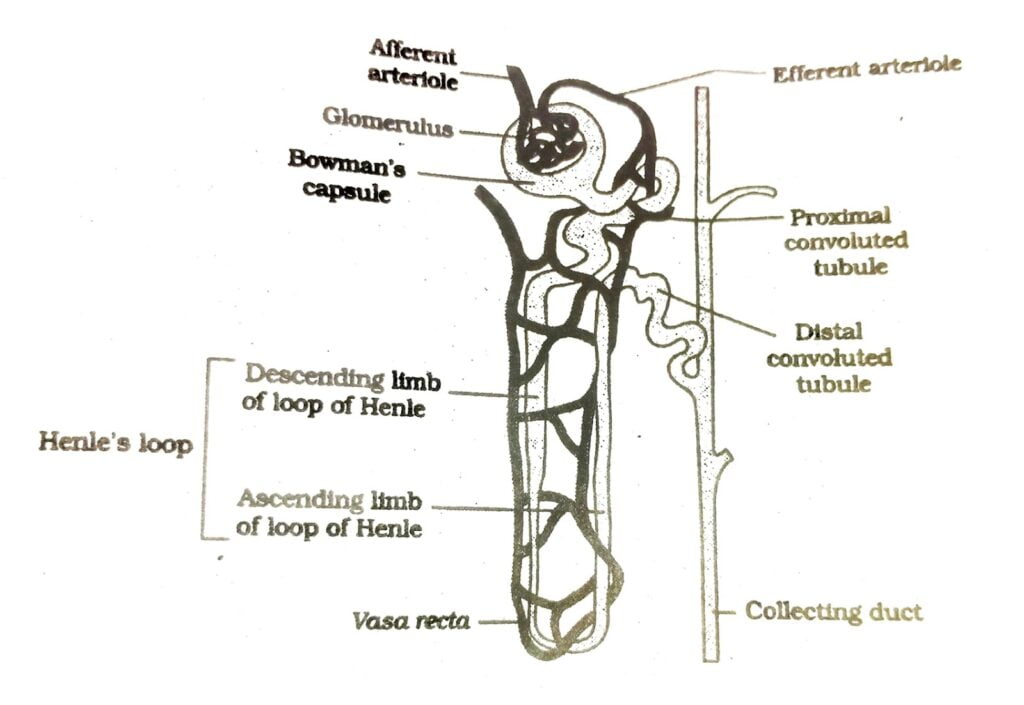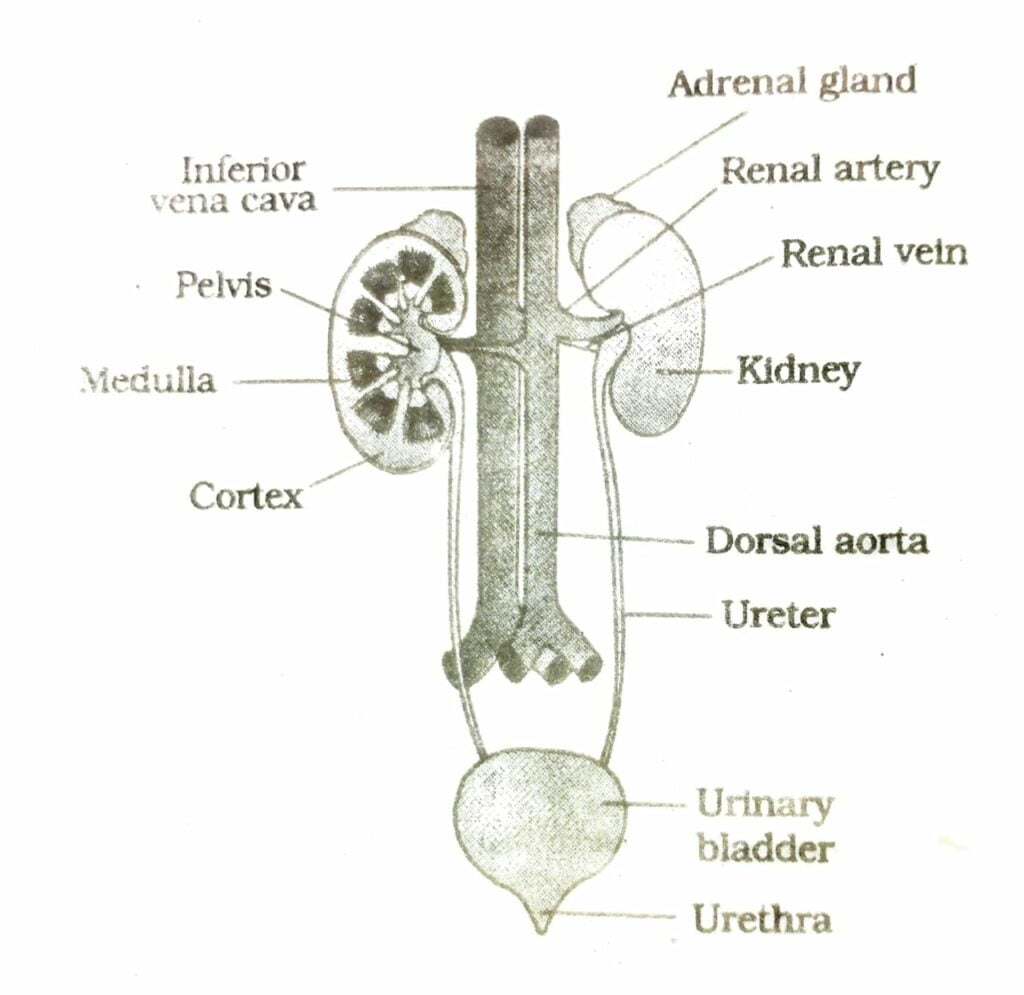Class 11 Biology Chapter 19 Excretory Products and Their Elimination, AHSEC Class 11 Biology Question Answer, HS 1st year Biology notes to each chapter are provided in the list so that you can easily browse throughout different chapters Assam Board Class 11 Biology Chapter 19 Excretory Products and Their Elimination Question Answer and select needs one.
Class 11 Biology Chapter 19 Excretory Products and Their Elimination
Also, you can read the SCERT book online in these sections Solutions by Expert Teachers as per SCERT (CBSE) Book guidelines. These solutions are part of SCERT All Subject Solutions. Here we have given Assam Board Class 11 Biology Chapter 19 Excretory Products and Their Elimination Solutions for All Subjects, You can practice these here.
Excretory Products and Their Elimination
Chapter – 19
VERY SHORT ANSWER TYPE QUESTIONS
Q.1. Define excretion?
Ans :- The process of removal of various nitrogenous waste product from our body is called excretion.
Q.2. What is Ammonotelism?
Ans :- The process of excreting ammonia is called Ammonotelism.
Q.3. Name the various nitrogenous waste product excreted by animals.
Ans :- Ammonia, Urea and Uric acid.
Q.4. Give 1eg each of ureotelic and uricotelic animals.
Ans :- Ureotelic animals – Fish.
Uricotelic animals – Birds.
Q.5. Name the excretory organ of the following animals.
(a) Prawn.
(b) Insect.
Ans :- (a) Green gland.
(b) Malpighian tubules.
Q.6. What is the other name for protonephridia.
Ans :- Flame cell.
Q.7. Where is our kidney located?
Ans :- Kidneys are situated between the level of last thoracic and 3ʳᵈ lumbar vertebra close to the dorsal wall of the abdominal cavity.
Q.8. What is Glomerulus?
Ans :- Glomerulus is a tuft of capillaries formed by afferent arteriole.
Q.9. Name the blood vessel through which blood is carried away from glomerulus.
Ans :- Efferent arterioles.
Q.10. What is Malpighian body?
Ans :- Glomerulus along with Bowman’s capsule is called malpighian body.
Q.11. Name the 2 types of Nephron present in our body.
Ans :- Cortical nephrons and juxta medullary nephrons.
Q.12. What is vasa recta?
Ans :- A blood vessel which runs parallel to the Henle loop is called vasa recta.
Q.13. What is JGA?
Ans :- JGA is a special sensitive region formed by cellular modification in the distal convoluted tubule and the efferent arteriole at the location of their contact.
Q.14. What is Uremia?
Ans :- Mulfunchenij of Kidneys can lead to accumulation of urea in blood, a condition called uremia.
Q.15. Name the process through which urea is removed from the person suffering from uremia.
Ans :- Hemodialysis.
Q.16. What happens in glomerulonephritic.
Ans :- In flammation of glomeruli of kidney occurs.
SHORT ANSWER TYPE QUESTIONS
Q.17. Name the other excretory organ present in our body other than kidney and also write the waste product removed by them.
Ans :- Lung – CO₂ +H₂O
Liver – Steroid hormones, vitamin & drags.
Skin – Nacl, small amount of urea, lactic acid.
Q.18. Write the function of sweat.
Ans :- (i) It facilitate a cooling effect on the body surface.
(ii) It also help in removing some of the waste product formed in our body.
Q.19. Why glomerular filtration is also termed as ultra filtration?
Ans :- Blood is filtered so finely through the endothelium of glomerulus blood vessels, epithelium of Bowman’s capsule and a basement membranes, that almost all the constituents of the plasma except the proteins pass on to the lumen of the bowman’s capsule. So it is considered as a process of ultra filtration.
Q.20. What is glomerular filtration rate? What happens when there is fall in GFR.
Ans :- The amount of the filtrate formed by the kidneys per minute is called glomerular filtration rate.
A fall in GFR can activate the JC cells to release rennin which can stimulate the glomerular blood flood flow and there by the GFR back to normal.
Q.21. What is the difference between rennin and renin.
Ans :- Rennin is the enzyme present in the stomach of infant and help in digestive of Milk where as Renin is the enzyme present in JG cell which help in regularly the function of kidney.
Q.22. Give the full form of ANF. What role does it play in our body.
Ans :- ANF – Atrial Natriuretic Factor.
ANF cause vasodilation and thereby decrease the blood pressure. ANF as a check on the rennin – angio tensin mechanism.
Q.23. Give the Diagrammatic representation of a nephron and vasa recta showing counter current mechanism.
Ans :-

Q.24. Give the diagrammatic representation of a nephron showing blood vessels, duct and tubule.
Ans :-

Q.25. Draw the Human Urinary system and locate the following parts Medulla, Pelvis, Contere, Kidney, Ureter, Urethra.
Ans :-

Q.26. Distinguish between juxta medullary nephron and cortical nephron.
Ans :- Juxta Medullary Nephron – loop of henle in very long and runs dips into the medulla vasa recta is present but in cortical rephnen loop of henle is very short and extend only very little into the medulla. Vasa recta is absent.
Q.27. What is collecting duct ? What role does it plays.
Ans :- Collecting duct is the long duct which extend from the cortex of the kidney to the inner part of the medulla.
Function :-
(i) Reabsorption of H₂O occurs to produce concentrate urine.
(ii) Also it allows passage of small amount of urea into the medullary interstitium to keep up the osmolarity.
(iii) It helps in the maintenance of Pᴴ and ionic balance of blood by relative secretion of H+ and K+ ions.
LONG ANSWER TYPE QUESTIONS
Q.28. Explain how loop of henle and vasa recta help in the concentrating the urine in human being Glomerular fluid in.
Ans :- Both henle’s loop and vasa recta flow in opposite directions in the two limbs of the loops, towards the renal medulla in the descending limb and towards the renal cortex in the ascending limb. There two countercurrent system help in concentrating the urine.
The proximity between the henle’s loop and vasa recta, as well as the courrter cunent in them help in maintaining an increasing osmolarity towards the inner medullary interstitium from 300 m Os mol-1 in the certex to about 1200 m Osmal-1 in the inner medulla. This gradient is caused by Nacl & Urea. Nacl is transported by the ascending limb of henle’s which is exchanged with the descending limb vas recta. Similarly small amount of urea enter ascending limb of henles which is transported back to the interstitium by the collecting duct. In this way counter current mechanism helps to maintain a concentration gradient in he medullary interstitium.
Q.29. How kidney function is regulated?
Ans :- The kidney function is regulated by the hormonal feedback mechanism that involve the hypothalamus, juxta glandular apparatus and Atrial wall of heart.
(i) By hypothalamus: An excessive loss of fluid from the body stimulates hypothalamus to release ADH from neurohypophysis. ADH help in H₂O reabsorption from later part of tubule thus preventing diuresis. An increase in body fluid volume can switch off the osmoreceps & stop the function of ADH.
(ii) By JGA: When the glomerular blood flow decreases, JGA releases renin, which convert, angiotensinogen in blood to angiotensin I and than to angiotensin II. Angiotensin II increases glomerular blood pressure and there by GFR.
Angiotensin II also activate adrenal cortex to release aldosterone which help in also absorption of Na+ and H₂O from DCT.
(iii) By heart : An increase in blood flow to the atria of the heart cause the release of ANF. ANF cause vasodilation and there by decreases the blood pressure. ANF mechanism act as a check on the renin – angiotensin mechanism.
Q.30. Explain how urine formation takes place.
Ans :- Urine formation involve 3 main processes filtration, reabsorption and tubular secretion.
(a) Glomerulus filtration: Filtration is a non selective process performed by the glomerulus using the glomerular capillary blood pressure. About 1200 ml of blood is filtered per minute to form 125 ml of filtrate in the Bowman’s capsule. The filtrates is caused by the blood pressure in the glomerular capillaries. Filtration occurs through 3 layers (endothelium of glomerular capillaries, epithelium of Bowman’s capsule and basement membrane between 2 layers), which form the filtration membrane. The blood is filtered so finely that the compura of the filtrate is very similar to plasma except for the plasma protein.
(b) Selective reabsorption: As the filtrate passes through the tubules of the nephron reabsorption of filtrate occurs in different part of nephron either by active or passive mechanism.
In PCT – (i) 70-80% of electrolytes and H₂O are reabsorbed.
(ii) It also maintain the ionic balance of the body fluid by relative secretion of H+, NH3+K+ into the filtrate by absorbing HCO₃.
In Henle’s loop:
Descending loop is permeable to H₂O and ascending loop is permeable to solutes.
In DCT:
Reabsorption of Na+, H₂O takes place in the segment also it reabsorb HCO₃ ion & secretes NH3, H+ and K+ into the filtrate.
In collecting duct:
Large amount of H₂O) are also reabsorbed from this region.
(c) Tubular secretion: Some substances the K+ and NH3 are secreted by the tubular wall. This step is important as it helps in the maintenance of ionic and acid base balance of body fluid.

Hi, I’m Dev Kirtonia, Founder & CEO of Dev Library. A website that provides all SCERT, NCERT 3 to 12, and BA, B.com, B.Sc, and Computer Science with Post Graduate Notes & Suggestions, Novel, eBooks, Biography, Quotes, Study Materials, and more.


